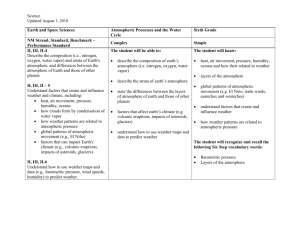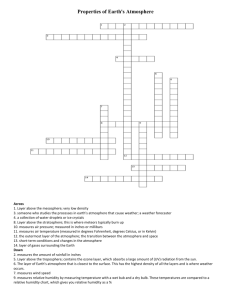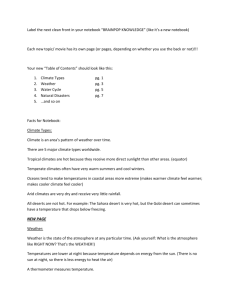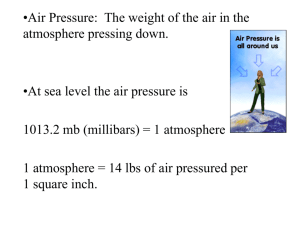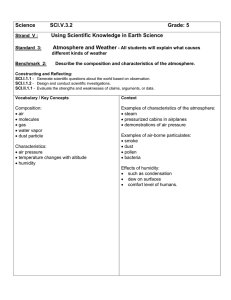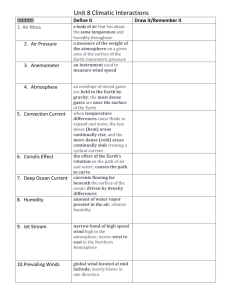Name: Period: ____ Date: Chapter 11 Notes
advertisement
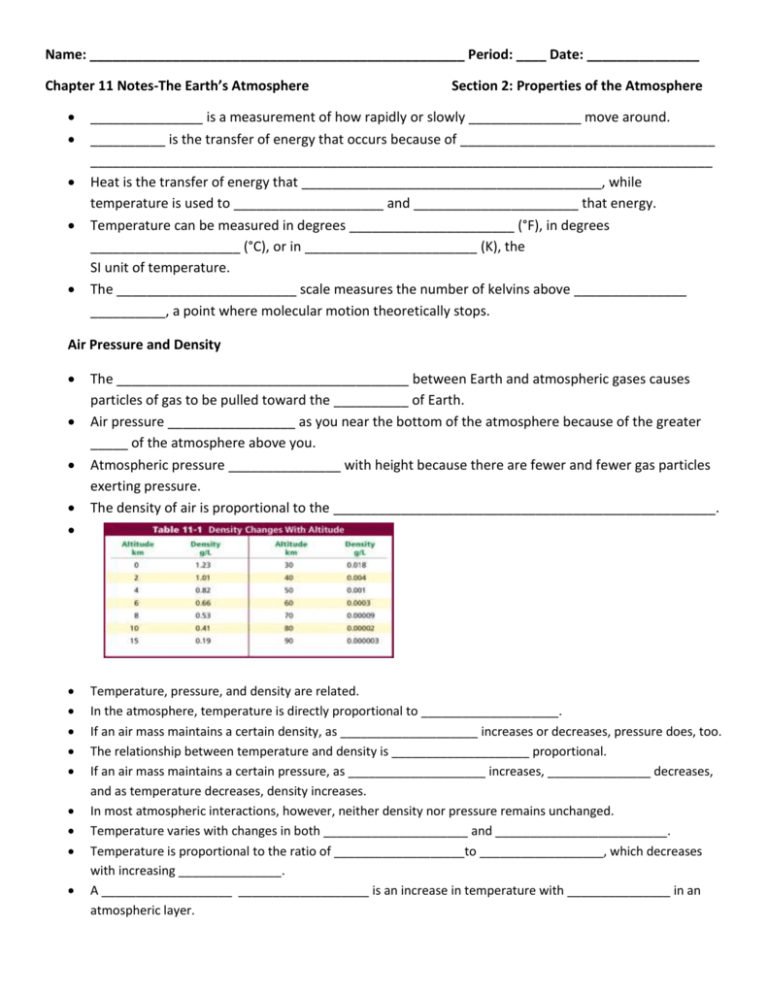
Name: __________________________________________________ Period: ____ Date: _______________ Chapter 11 Notes-The Earth’s Atmosphere Section 2: Properties of the Atmosphere _______________ is a measurement of how rapidly or slowly _______________ move around. __________ is the transfer of energy that occurs because of __________________________________ ___________________________________________________________________________________ Heat is the transfer of energy that ________________________________________, while temperature is used to ____________________ and ______________________ that energy. Temperature can be measured in degrees ______________________ (°F), in degrees ____________________ (°C), or in _______________________ (K), the SI unit of temperature. The ________________________ scale measures the number of kelvins above _______________ __________, a point where molecular motion theoretically stops. Air Pressure and Density The _______________________________________ between Earth and atmospheric gases causes particles of gas to be pulled toward the __________ of Earth. Air pressure _________________ as you near the bottom of the atmosphere because of the greater _____ of the atmosphere above you. Atmospheric pressure _______________ with height because there are fewer and fewer gas particles exerting pressure. The density of air is proportional to the ___________________________________________________. Temperature, pressure, and density are related. In the atmosphere, temperature is directly proportional to ____________________. If an air mass maintains a certain density, as ____________________ increases or decreases, pressure does, too. The relationship between temperature and density is ____________________ proportional. If an air mass maintains a certain pressure, as ____________________ increases, _______________ decreases, and as temperature decreases, density increases. In most atmospheric interactions, however, neither density nor pressure remains unchanged. Temperature varies with changes in both _____________________ and _________________________. Temperature is proportional to the ratio of ___________________to __________________, which decreases with increasing _______________. A ___________________ ___________________ is an increase in temperature with _______________ in an atmospheric layer. This can happen when the lower layers of the atmosphere__________ __________ to Earth’s surface and become __________ than the air above them. A temperature inversion can act like ________________________________________________under the inversion layer. In all cases, the presence or absence of inversions can have a profound effect on_________________________ ___________________________. Air moves in response to ___________________ ________________________ created by the ______________ heating and cooling of Earth’s surface. These imbalances, in turn, create areas of __________ and __________ pressure. __________ can be thought of as air moving from an area of __________ pressure to an area of _____ pressure. Wind speed generally increases with ________________ in the atmosphere because there is less ____________. Air in the lower portion of the atmosphere always contains at least some __________ __________. ____________________ is the amount of water vapor in air. ____________ _______________ is the ratio of water vapor in a volume of air compared to how much water vapor that volume of air is capable of holding. Relative humidity varies with temperature because _________________________________________________ If the temperature of an air parcel increases and no additional water vapor is added, its relative humidity _______________. If more water vapor is added to the parcel, its relative humidity _______________. Relative humidity is expressed as a _____________. If a certain volume of air is holding as much water vapor as it possibly can, then its relative humidity is _____%. If that same volume of air is holding half as much water vapor as it can, its relative humidity is _____ %, and so on. The __________ __________ is the temperature to which air must be cooled at constant pressure to reach _______________. ____________________ is the point at which the air holds as much water vapor as it possibly can. Condensation cannot occur until air is _________________. ____________________ occurs when matter changes state from a _____ to a _____________. The temperature of the lower atmosphere _______________ with increasing distance from Earth’s surface. An air mass that does not exchange heat with its surroundings will cool off by about _____°C for every __________ increase in altitude. The __________ ____________ __________ __________ is the rate at which unsaturated air, to which no heat is added or removed, will __________. If the air is able to continue rising, eventually it will cool to its ____________________ temperature. The __________ ____________________ __________, or LCL, is the height at which condensation occurs. The __________ _______________ __________ __________ rate is the rate at which saturated air cools and ranges from about _____°C/1000 m in very warm air to almost ______°C/1000 m in very cold air.

